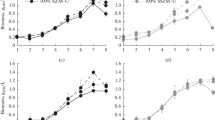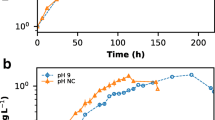Abstract
The rates of growth, cell size, elemental and biochemical composition ofDunaliella primolecta were monitored during exponential growth after conditioning over three weeks in media containing different concentrations of nitrogen. The rate of growth, measured both as cell density and cell volume, was correlated positively with the N concentration of the medium (P<0.01). N-starved cells did not grow and died within three days. Cell volume and dry weight per cell were significantly higher (P<0.01) in the N-low (0.45 μg-at 1−1 NO3-N) condition than in the N-high I condition (3.53 μg-at 1−1 NO3-N). In the N-high II condition the addition of 1.87 μg-at 1−1 NH4-N to 3.53 μg-at 1−1 NO3-N did not significantly enhance growth.
The composition was influenced by the availability of nitrogen. The amount of protein per cell decreased significantly from 20.1 to 9.7 pg with reduced nitrate availability between the N-high condition and the N-low condition (P<0.01). The associated carbohydrate content increased significantly from 10.6 to 26.74 pg per cell (P<0.001). These findings confirm the potential for significant variability in the composition ofD. primolecta, both in the natural environment and following experimental manipulation.
Similar content being viewed by others
References
Alvarez M (1989) Lipids in microalgae. A review II. Environment. Grasas y Aceites 40: 213–223.
Barnes H, Blackstock J (1973) Estimation of lipids in marine animals and tissues: detailed investigation of the sulphophosphovanillin methods for ‘total’ lipids. J. exp. mar. Biol. Ecol. 12: 103–118.
Borowitzka MA, Borowitzka LJ (1988)Dunaliella. In: Borowitzka MA, Borowitzka LJ (eds), Microalgal Biotechnology. Cambridge Univ. Press, 27–58.
Brown MR (1991) The amino-acid and sugar composition of 16 species of microalgae used in mariculture. J. exp. mar. Biol. Ecol. 145: 79–99.
Brown MR, Jeffrey SW, Garland CD (1989) Nutritional aspects of microalgae used in mariculture; a literature review. CSIRO Marine Laboratories. Report 205. 43 pp.
Burkill PH, Mantoura RFC (1990) The rapid analysis of single marine cells by flow cytometry. Phil. Trans. R. Soc., Lond. 333: 99–112.
Caperon J, Meyer J (1972) Nitrogen-limited growth of marine phytoplankton I. Changes in population characteristics with steady-state growth rate. Deep Sea Res. 19: 601–618.
Enright CT, Newkirk GF, Craigie JS, Castell JD (1986) Evaluation of phytoplankton as diets for juvenileOstrea edulis L. J. exp. mar. Biol. Ecol. 96: 1–13.
Enright CT, Newkirk GF, Craigie JS, Castell JD (1986) Growth of juvenileOstrea edulis L. fedChaetoceros gracilis Schütt of varied chemical composition J. exp. mar. Biol. Ecol. 96: 15–26.
Fabregas J, Herrero C (1985) Marine microalgae as a potential source of single cell protein (SCP). Appl. Microbiol. Biotechnol. 23: 110–113.
Flynn KJ, Butler I (1986) Nitrogen sources for the growth of marine microalgae: role of dissolved free amino acids. Mar. Ecol. Progr. Ser. 34: 281–304.
Folch J, Lees M, Sloane-Stanley GM (1957) A simple method for the isolation and purification of total lipids from animal tissues J. biol. Chem. 226: 497–509.
Guillard R, Ryther J (1962) Studies on marine planktonic diatoms. I.Cyclotella nana Hustedt andDenotula confervacea (Cleve) Gran. Can. J. Microbiol. 8: 229–239.
Harrison PJ, Thompson PA, Calderwood GS (1990) Effects of nutrient and light limitation on the biochemical composition of phytoplankton. J. appl. Phycol. 2: 345–356.
Hawkins AJS, Bayne BL (1991) Nutrition of marine mussels: factors influencing the relative utilizations of protein and energy. Aquaculture 94: 177–196.
Hellebust JA, Craigie JS (1978) Handbook of Phycological Methods. Physiological and Biochemical Methods. Cambridge U.P., 512 pp.
Hobson LA, Pariser RJ (1971) The effect of inorganic nitrogen on macromolecular synthesis byThalassiosira fluviatilis Hustedt andCyclotella nana Hustedt grown in batch culture. J. exp. mar. Biol. Ecol. 6: 71–78.
Lowry OH, Rosebrough NJ, Farr AL, Randall RJ (1951) Protein measurement with the Folin phenol reagent. J. biol. Chem. 193: 265–275.
McCombie AM (1953) Factors influencing the growth of phytoplankton J. Fish Res. Bd Can. 10 (5): 253–282.
Myklestad S, Haug A (1972) Production of carbohydrates by the marine diatomChaetoceros affinis var.willei (Gran.) Hustedt. I. — Effect of the concentration of nutrient in the culture medium. J. exp. mar. Biol. Ecol. 9: 125–136.
Renaud SM, Parry DL, Thinh LV, Kuo C, Padovan A, Sammy N (1991) Effect of the light intensity on the proximate biochemical and fatty acid composition ofIsochrysis sp. andNannochloropsis occulata for use in tropical aquaculture. J. appl. Phycol. 3: 43–53.
Shah N, Syrett PJ (1984) The uptake of guanine and hypoxanthine by marine microalgae J. mar. biol. Ass. U.K. 64: 545–556.
Shifrin NS, Chisholm SW (1981) Phytoplankton lipids: interspecific differences and effects of nitrate, silicate and light-dark cycles. J. Phycol. 17: 374–384.
Sokal R, Rohlf F (1981) Biometry. Freeman, New York. 859 pp.
Thomas WH, Seibert DLR, Alden M, Neori A, Eldridge P (1984) Yields, photosynthetic efficiencies and proximate composition of dense marine microalgal cultures II.Dunaliella primolecta andTetraselmis suecica experiments. Biomass 5: 211–225.
Uriarte I (1990) Estudio Comparativo de la Citología, Fisiología y Bioquímica de Diatomeas Marinas Thalassiosiraceas. Ph.D. thesis. University of Barcelona. 298 pp.
Utting SD (1985) Influence of nitrogen availability on the biochemical composition of the three unicellular marine algae of commercial importance. Aquaculture Engineering, 4: 175–190.
Utting SD (1986) A preliminary study on growth ofCrassostrea gigas larvae and spat in relation to dietary protein. Aquaculture 56: 123–138.
Walne P (1966) Experiments in the large scale culture of the larvae ofOstrea edulis L. Fishery Invest. Lond. (Ser. 2) 25: 1–53.
Wikfors GH (1986) Altering growth and gross chemical composition of two microalgal molluscan food species by varying nitrate and phosphate. Aquaculture, 59: 1–14.
Wikfors GH, Twarog JW, Ukeles R (1984) Influence of chemical composition of algal food sources on growth of juvenile oysters,Crassostrea virginica. Biol. Bull. 167: 251–263.
Author information
Authors and Affiliations
Rights and permissions
About this article
Cite this article
Uriarte, I., Farías, A., Hawkins, A.J.S. et al. Cell characteristics and biochemical composition ofDunaliella primolecta Butcher conditioned at different concentrations of dissolved nitrogen. J Appl Phycol 5, 447–453 (1993). https://doi.org/10.1007/BF02182737
Received:
Revised:
Accepted:
Issue Date:
DOI: https://doi.org/10.1007/BF02182737




